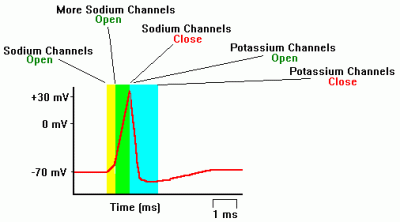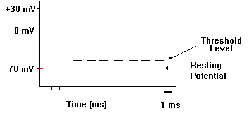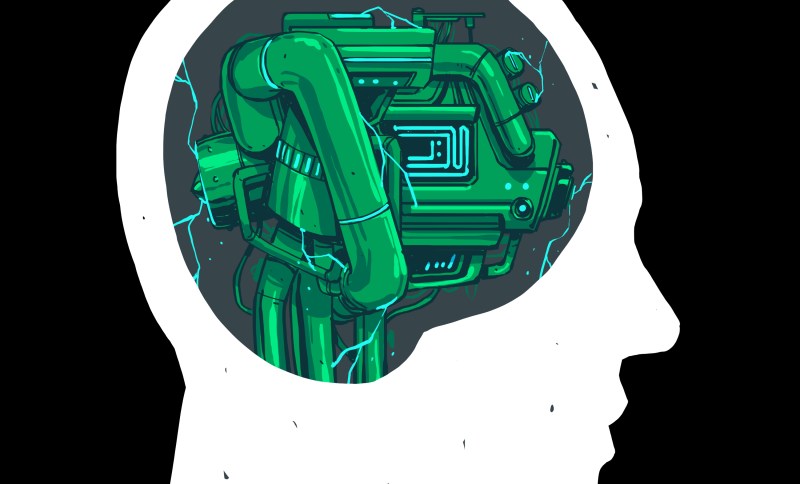It’s not too often that you see handkerchiefs around anymore. Today, they’re largely viewed as unsanitary and well… just plain gross. You’ll be quite disappointed to learn that they have absolutely nothing to do with this article other than a couple of similarities they share when compared to your neocortex. If you were to pull the neocortex from your brain and stretch it out on a table, you most likely wouldn’t be able to see that not only is it roughly the size of a large handkerchief; it also shares the same thickness.
The neocortex, or cortex for short, is Latin for “new rind”, or “new bark”, and represents the most recent evolutionary change to the mammalian brain. It envelopes the “old brain” and has several ridges and valleys (called sulci and gyri) that formed from evolution’s mostly successful attempt to stuff as much cortex as possible into our skulls. It has taken on the duties of processing sensory inputs and storing memories, and rightfully so. Draw a one millimeter square on your handkerchief cortex, and it would contain around 100,000 neurons. It has been estimated that the typical human cortex contains some 30 billion total neurons. If we make the conservative guess that each neuron has 1,000 synapses, that would put the total synaptic connections in your cortex at 30 trillion — a number so large that it is literally beyond our ability to comprehend. And apparently enough to store all the memories of a lifetime.
In the theater of your mind, imagine a stretched-out handkerchief lying in front of you. It is… you. It contains everything about you. Every memory that you have is in there. Your best friend’s voice, the smell of your favorite food, the song you heard on the radio this morning, that feeling you get when your kids tell you they love you is all in there. Your cortex, that little insignificant looking handkerchief in front of you, is reading this article at this very moment.
What an amazing machine; a machine that is made possible with a special type of cell – a cell we call a neuron. In this article, we’re going to explore how a neuron works from an electrical vantage point. That is, how electrical signals move from neuron to neuron and create who we are.
A Basic Neuron

Despite the amazing feats a human brain performs, the neuron is comparatively simple when observed by itself. Neurons are living cells, however, and have many of the same complexities as other cells – such as a nucleus, mitochondria, ribosomes, and so on. Each one of these cellular parts could be the subject of an entire book. Its simplicity arises from the basic job it does – which is outputting a voltage when the sum of its inputs reaches a certain threshold, which is roughly 55 mV.
Using the image above, let’s examine the three major components of a neuron.
Soma
The soma is the cell body and contains the nucleus and other components of a typical cell. There are different types of neurons whose differing characteristics come from the soma. Its size can range from 4 to over 100 micrometers.
Dendrites
Dendrites protrude from the soma and act as the inputs of the neuron. A typical neuron will have thousands of dendrites, with each connecting to an axon of another neuron. The connection is called a synapse but is not a physical one. There is a gap between the ends of the dendrite and axon called a synaptic cleft. Information is relayed through the gap via neural transmitters, which are chemicals such as dopamine and serotonin.
Axon
Each neuron has only a single axon that extends from the soma, and acts similar to an electrical wire. Each axon will terminate with terminal fibers, forming synapses with as many as 1,000 other neurons. Axons vary in length and can reach a few meters long. The longest axons in the human body run from the bottom of the foot to the spinal cord.
The basic electrical operation of a neuron is to output a voltage spike from its axon when the sum of its input voltages (via its dendrites) crosses a specific threshold. And since axons are connected to dendrites of other neurons, you end up with this vastly complicated neural network.
Since we’re all a bunch of electronic types here, you might be thinking of these ‘voltage spikes’ as a difference of potential. But that’s not how it works. Not in the brain anyway. Let’s take a closer look at how electricity flows from neuron to neuron.
Action Potentials – The Communication Protocol of the Brain
The axon is covered in a myelin sheet which acts as an insulator. There are small breaks in the sheet along the length of the axon which are named after its discoverer, called Nodes of Ranvier. It’s important to note that these nodes are ion channels. In the spaces just outside and inside of the axon membrane exists a concentration of potassium and sodium ions. The ion channels will open and close, creating a local difference in the concentration of sodium and potassium ions.

We all should know that an ion is an atom with a charge. In a resting state, the sodium/potassium ion concentration creates a negative 70 mV difference of potential between the outside and inside of the axon membrane, with there being a higher concentration of sodium ions outside and a higher concentration of potassium ions inside. The soma will create an action potential when -55 mV is reached. When this happens, a sodium ion channel will open. This lets positive sodium ions from outside the axon membrane to leak inside, changing the sodium/potassium ion concentration inside the axon, which in turn changes the difference of potential from -55 mV to around +40 mV. This process in known as depolarization.

One by one, sodium ion channels open along the entire length of the axon. Each one opens only for a short time, and immediately afterward, potassium ion channels open, allowing positive potassium ions to move from inside the axon membrane to the outside. This changes the concentration of sodium/potassium ions and brings the difference of potential back to its resting place of -70 mV in a process known as repolarization. Fro start to finish, the process takes about five milliseconds to complete. The process causes a 110 mV voltage spike to ride down the length of the entire axon, and is called an action potential. This voltage spike will end up in the soma of another neuron. If that particular neuron gets enough of these spikes, it too will create an action potential. This is the basic process of how electrical patterns propagate throughout the cortex.
The mammalian brain, specifically the cortex, is an incredible machine and capable of far more than even our most powerful computers. Understanding how it works will give us a better insight into building intelligent machines. And now that you know the basic electrical properties of a neuron, you’re in a better position to understand artificial neural networks.
Sources
Action Potential in Neurons, via Youtube
On Intelligence, by Jeff Hawkins, ISDN 978-0805078534
















This article sugests the voltage spike travels accros the synapse via the use of a similar process to the signal propigation down the axion, using sodium and potassium ions. This isn’t the case. when the signal reaches the Synapse it triggers the opening of channels for neuro-transmitters to be released into the synaptic gap. These vary in different parts of the nervous system (and different parts of the brain) but are detected by the dendrite by special protiens in the synaptic gap. It is a fascinating process (if you’re into that sort of thing) allowing the signal to propigate whilst also electrically isolating the components (the synapse acting almost like a optical coupler (although it is chemical in nature))
Throw in hormones and things get real interesting. BTW Our gut is sometimes referred to as our *second brain*.
” Every memory that you have is in there.”
Is it? I’ve thought it’s more like the distilled essentials of an experience.
“The mammalian brain, specifically the cortex, is an incredible machine and capable of far more than even our most powerful computers. ”
Quantum even? Or do our “computers” use quantum effects too?
To be fair, our quantum computers aren’t very powerful. So long as you can factor 143 you’re smarter than the best quantum computer I am aware of.
Our “computers” are so capable that they created an external data storage system and after a lot of data synchronization and revisions, they finally created new external computing devices, including those that utilize quantum effects.
This. I think the distinction between the depth of human sentience and the raw “computational power” that machines (which we designed) posses is the source of much confusion and many strange comparisons.
Great article! So it explain why our thought takes different path based on the level of our hormones.
Fantastic article! I’ve always been fascinated with neurology (getting a TBI at a young age will do that to a person), and articles like this, ones that distill the subject down to terms I can understand clearly, are a welcome sight. Thank you very much for writing it.
If you look at the brain form a macroscopic level (EEG), then the highest frequency that you see is around 100 Hz ( ref: https://en.wikipedia.org/wiki/Gamma_wave ). And yet due to its asynchronous and parallel nature and in terms of efficiency, it is totally mind blowing.
Does that mean the mind blows itself?
“It’s not too often that you see handkerchiefs around anymore. Today, they’re largely viewed as unsanitary and well… just plain gross.”
Man, that’s bad… A Gentleman ALWAYS carries a fresh-clean handkerchief; better two (like I do). One back-pocket “square” for personal use and breast-pocket square otherwise untouched for emergencies – to help others. The breast-pocket square is also a Gentleman’s Fashion-Statement when wearing a suit. Adjust your personal/public hygiene in a positive way Will Sweatman, and always carry at least one Handkerchief, and use it responsibly!
Good article, but it’s only half the story. The action potential cascade probably accounts for perception and calculation, our ability to recognize patterns in our environment and make plans based on them. Short-term memories are also probably held by action potential loops. But long-term memories, the ones that persist after unconsciousness, are probably formed by the growth of new dendrites. We have some pretty good evidence that this is the case; my favorite example is that the brains of songbirds raised in a song-rich environment reliably end up weighing more than the brains of songbirds raised in quiet. This is how the patterns form that are detected by action potential cascades. And other than a suspicion that the mechanism has something to do with growing new dendrites and synapses, we really have no idea what the mechanisms or rules are for how that happens.
So in other words I need more action potential loops? Wonder how well that works with mnemonics?
Mnemonics probably work by leveraging existing long-term pathways, those grown dendrites, to shorten the loop path for new short-term memories. Short term memories which persist long enough are somehow encoded by dendritic and synaptic growth into long-term memories. I’m out on a bit of a limb here, as we really don’t know much about long term storage except that it seems to involve tissue growth, but I’d bet this is the direction we’ll find it goes.
i don’t get the handkerchief thing… our entire cortex is only the size and thickness of a handkerchief? isn’t the coretex the entirety of the cauliflower/grey matter thing in two meaty hemispheres?
Well, it’s kinda folded and the interesting stuff happens on the ‘outside’. No, I don’t really understand how anything in my head works.
Most of that’s axons (“wires”). See the cutaway view here http://www.sciencephoto.com/media/119681/view. The white is axons.
Don’t hate… Myelinate!
No inclusion of microtubules here – Update necessary! The Neuron multiplies in complexity by an order of magnitude when you consider the potential for microtubule tubulin pattern variability.
I see a recurrent pattern on HaD lately: people writing about stuff they are not familiar with. The article makes the most classical mistake in action potential propagation description:
“This lets positive sodium ions from outside the axon membrane to leak inside, changing the sodium/potassium ion concentration inside the axon, which in turn changes the difference of potential from -55 mV to around +40 mV.”
No. It doesn’t. The concentrations stay (almost) the same. Only a tiny fraction of ions ever cross the membrane. Only, until the membrane capacity is discharged. Otherwise the neuron could only fire once and would then have to pump the ions back before it could be retriggered. Not very efficient.
Please stick to stuff you know about!
Haha you say “No. It doesn’t”, then proceed to describe how it does.
Like most of my articles, this one is meant to convey a very basic explanation of neurons. But we welcome more detailed comments such as yours.